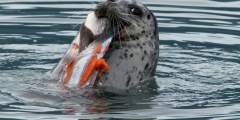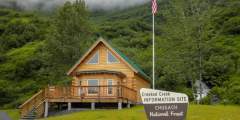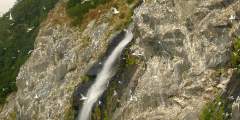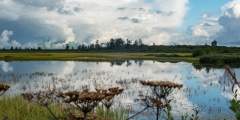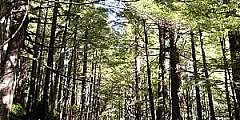The Best Wildlife Viewing Spots in Prince William Sound
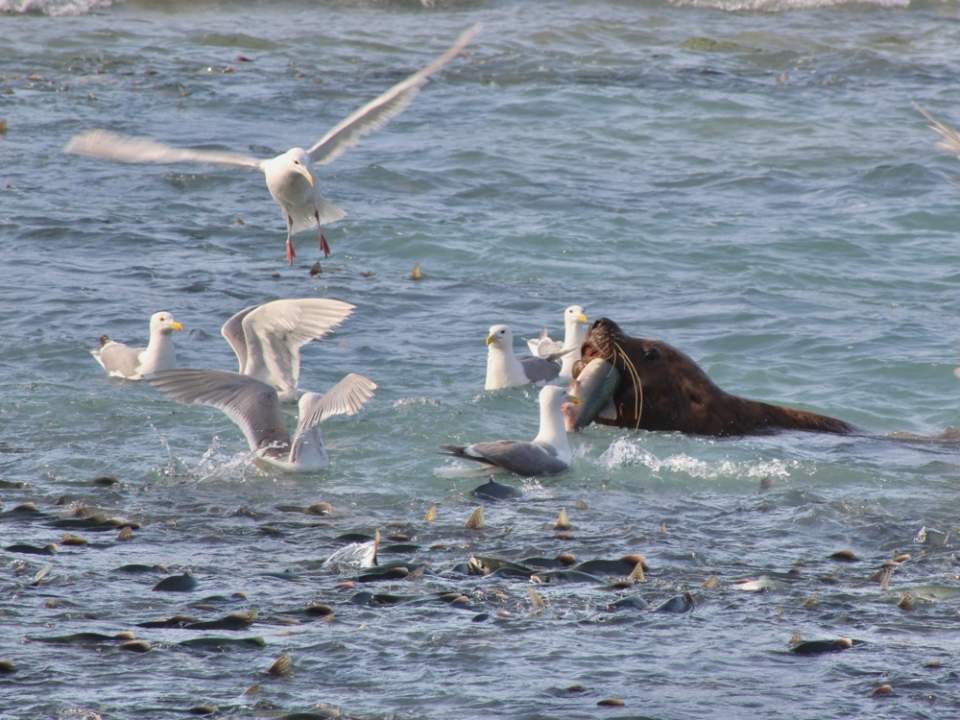
Sea Lion snatches a salmon at the Solomon Creek Hatchery. Photo: Shaton Wheeler
Bald eagles. Brown bears. Black bears. Humpback whales. Orcas. Stellar sea lions. Harbor seals. Sea otters. Moose. Wolves. 200,000 seabirds of over 220 different species.
You can find this impressive collection of iconic Alaskan animals right in Prince William Sound. Here’s where to go in each town for the best wildlife-viewing opportunities!
Valdez
Dayville Road & Solomon Creek Salmon Hatchery
What to See: When the salmon are returning, the drive out Dayville Road is a great chance to see wildlife without having to travel far. Pink salmon return in the millions to the hatchery, and seeing the creek thick with their bodies is certainly impressive. Adding to the excitement are sea lions and sea otters getting their fill of salmon, as well as bears wading into the water for their catch.
When: Peak is late June to mid-July
How to Get There: The hatchery is just a 15-minute drive down Dayville Road from downtown Valdez. There’s a big parking area just beyond the hatchery with ample parking for RVs, too. Walk to the hatchery on the path along the creek, or take the sidewalk along the road.
Crooked Creek
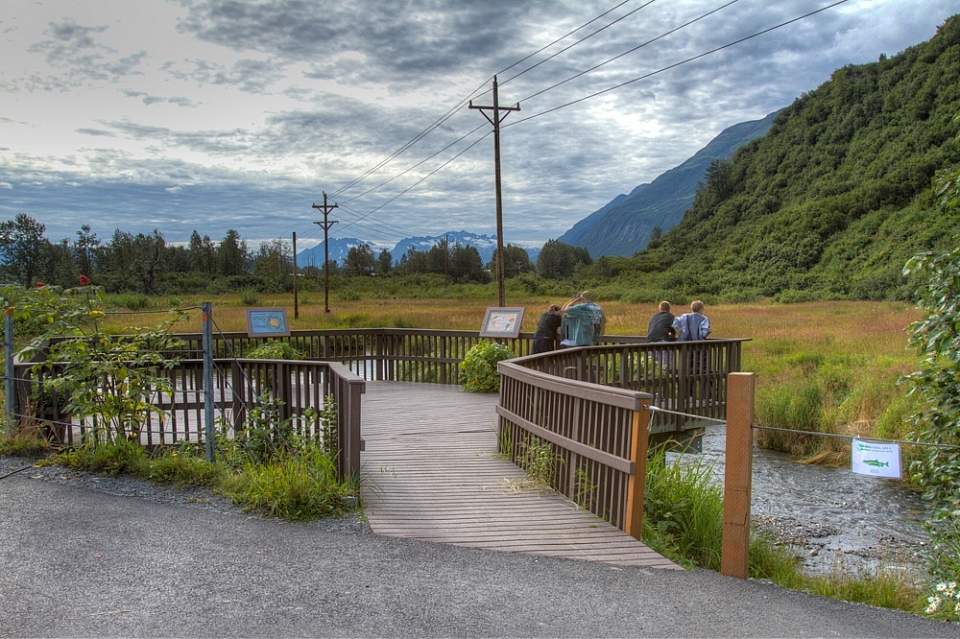
Crooked Creek Information Site Cabin
What to See: The USFS Crooked Creek Information Site Cabin is situated near Crooked Creek, where a stream runs thick with pink and chum salmon when they return each summer to spawn. Thanks to a footbridge over the stream and the clear Alaskan water, it’s easy to see the fish. You may also see black bears, which come to feast on the fish.
When: Mid-July through October
How to Get There: The cabin is located at Mile .5 of the Richardson Highway, just a 2-minute drive from downtown.
Duck Flats
What to See: The flats offer nesting grounds for waterfowl, so it’s a popular spot for birding. You might see gorgeous species like Harlequin ducks, Arctic terns, red-necked grebes, bald eagles, sandpipers, gulls, and great blue herons. It’s also a rearing ground for pink salmon, especially from the nearby Solomon Gulch Salmon Hatchery. In addition to seeing the fish, you may also spot black and brown bears who feast on them. And keep an eye out for the occasional sea otter. Bring binoculars!
When: May to September
How to Get There: Park at the Crooked Creek Information Site, a 2-minute drive from downtown. Follow the bike path from the parking area; you can check out the flats across the highway from the path.
Shoup Bay
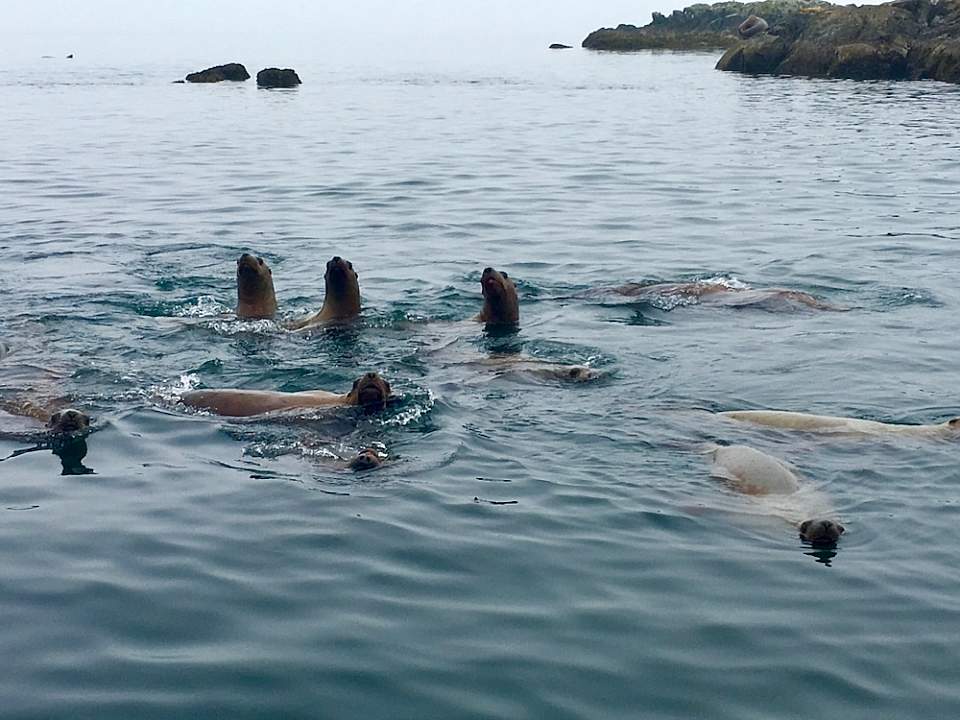
Sea Lions in near Egg Rocks. Photo: Lazy Otter Charters
What to See: Shoup Bay State Marine Park, located 5 miles southwest of the Port of Valdez, is home to an impressive black-legged kittiwake rookery. The best way to access the marine park is by water taxi or on a guided sea kayak tour. You may also see bald eagles and other species of waterfowl.
When: May to September
How to Get There: Charter a water taxi or take a guided sea kayaking tour.
Whittier
Perry Island & Egg Rocks
What to See: Sea lions are an impressive sight, with males weighing in around 1,200 pounds and females over 500 pounds. The sight of a rocky island packed with these “sea bears”—enormous bulls and harems of smaller cows (some with nursing pups)—is one of Alaska’s most extraordinary wildlife spectacles. You can see them almost year-round, but fewer are visible in early summer and late fall.
When: Year-round
How to Get There: Take a day cruise, water taxi, or multi-day cruise from Whittier.
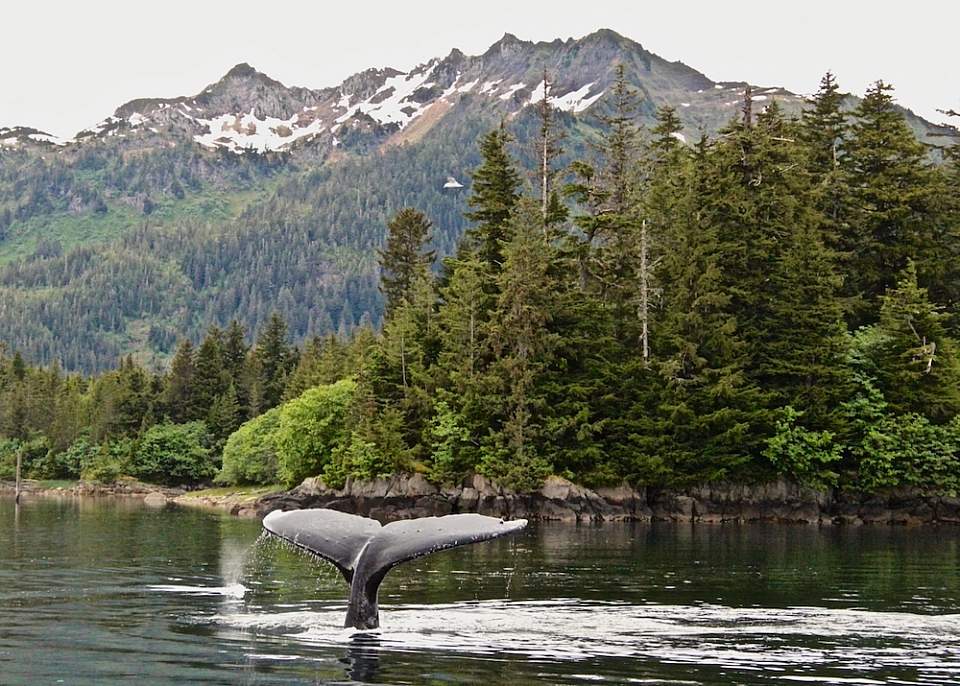
Humpback Whale. Photo: Lazy Otter Charters
Lake Bay Salmon Hatchery
What to See: Four species of salmon return here to spawn each year; kings, silvers, pinks, and chum. And heading to Lake Bay to see them is a real treat. During the peak of the run, you can’t miss salmon jumping everywhere. And you’ll also see sea lions and sea otters coming after them for a delicious feast.
When: Late May to August. King salmon: Late May through early July. Silver salmon: Early August through early September. Pink salmon: Mid-July through late August. Chum salmon: Early June through early July.
How to Get There: Take a water taxi or multi-day cruise from Whittier.
Port Wells
What to See: This is a popular spot for day cruises from Whittier because it’s en-route to College Fjord and Harvard Glacier. It’s a fantastic place to see humpback whales who return to Alaska each summer to feed on the nutrient-rich waters. It’s also home to the largest population of sea otters in the Sound. If you’ve never seen a “raft” of otters (that’s what a group is called!), you might here!
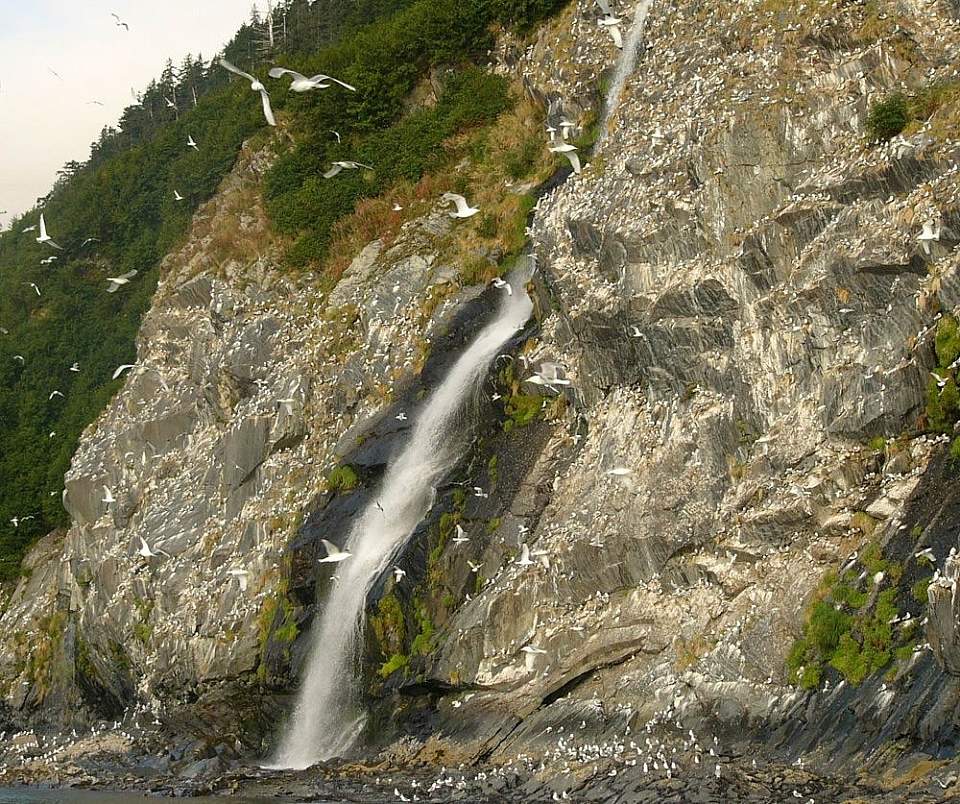
Kittiwake Rookery Falls
When: May to September
How to Get There: Take a day cruise from Whittier.
Rookery Falls
What to See: This dramatic waterfall spills down from 200 feet up the mountain cliffs into the waters of Passage Canal, just across from Whittier. And if that wasn’t impressive enough, it runs right through one of the largest bird rookeries in Prince William Sound. With up to 8,000 screeching, black-legged kittiwakes as well as the roaring whitewater, the area makes for a truly memorable experience.
When: May to September
How to get there: Take a day cruise, kayak tour, or Jet Ski tour.
Cordova
Alaganik Slough
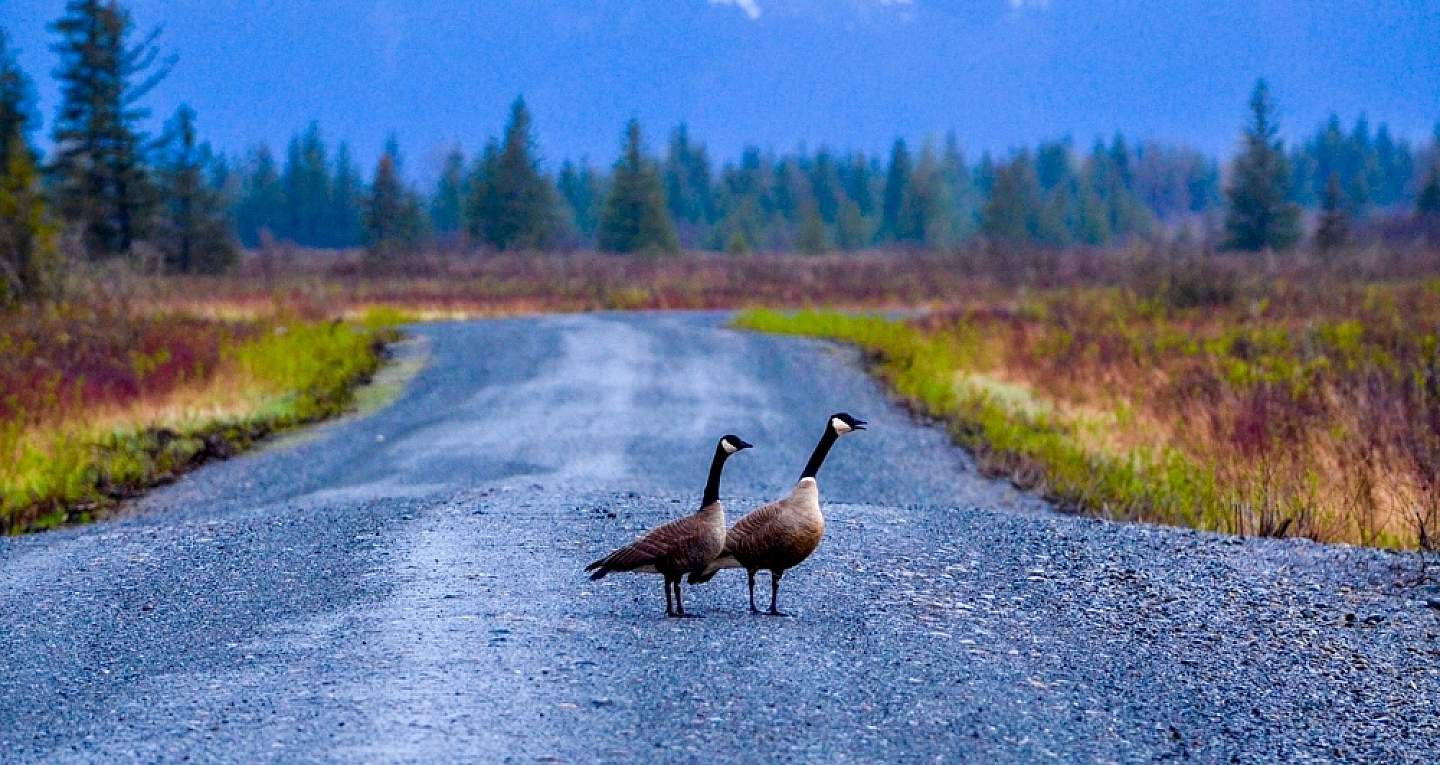
Geese cross Alaganik Road. Photo: Wendy Ranney
What to See: This is a springtime hot spot for wildlife viewing, thanks to the massive numbers of hooligan (or candlefish) and the animals—seals, sea lions, and birds—that come to feast on them. In early May, it’s also a great spot to see migrating shorebirds. Walk the boardwalk and take advantage of the observation deck and wildlife blind, where there’s excellent bird watching; you may also see bears, wolves, and moose. The drive down Alaganik Road also offers the opportunity to spot wildlife, especially moose.
When: Year-round, but May/June is a particularly active time
How to Get there: Turn onto Alaganik Slough Road at Mile 17 of the Copper River Highway. Follow the road for 3 miles.
Power Creek Road
What to See: Just past the end of Eyak Lake, you’ll find a little creek with a natural run of sockeye salmon. It was developed into a bit of hatchery years ago; while that no longer exists, you can still see some sockeye salmon spawning, along with eagles and even sometimes bears. As many as 20 bears have been seen at once when the salmon are in. Practice bear safety!
When: Mid-June to mid-August
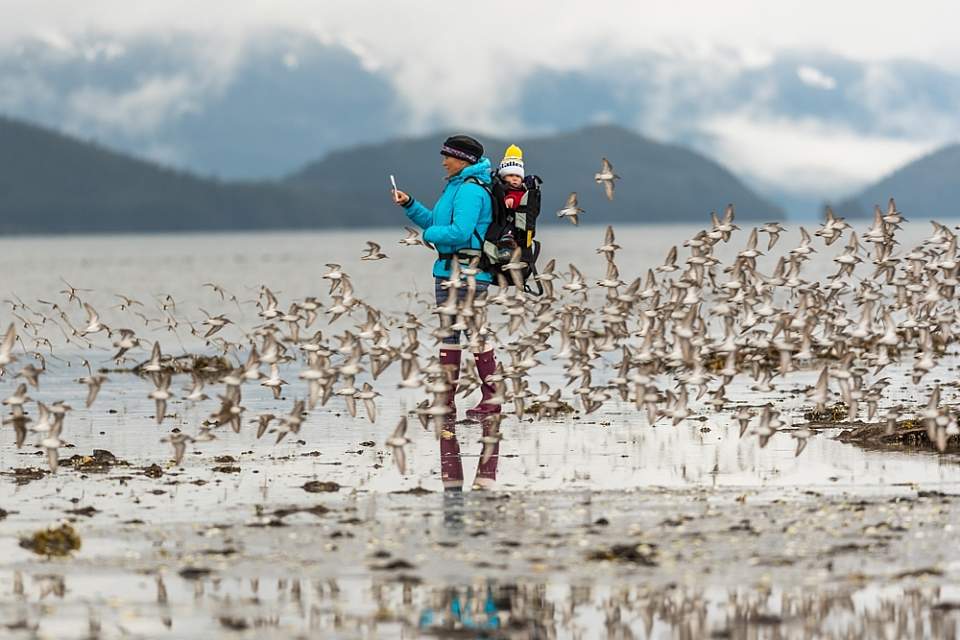
Shorebirds at Hartney Bay
How to Get there: Follow Lake Ave toward Eyak Lake, where the road winds around the shore beyond the airstrip.
Hartney Bay
What to See: Shorebirds galore. Every year, millions of shorebirds migrate from South America to Alaska, where they stop to rest and feed on the Copper River Delta mud flats at Hartney Bay. Each year at the beginning of May, the mud flats play host to thousands of Western Sandpipers during high tide. Bring binoculars! This area also has potential for great bear viewing when the salmon are running. Stand on the Hartney Bay Bridge and look inland.
When: Early May
How to Get There: Drive about 5 miles south of Cordova near the end of Whitshed Road
Show Map
Best Wildlife Viewing Spots in Prince William Sound
Valdez
When the salmon spawn from mid-June through August, the waters of the Solomon Gulch Fish Hatchery run thick with pink and Coho salmon. Their presence attracts creatures who love to eat these delicious fish, so you may also spot sea lions out in the water, swimming with fish in their mouths. You may also see black and brown bears fishing from shore, especially at low tide.
Operated by the U.S. Forest Service and open only in summertime, it’s staffed by guides who can help you understand the area. There’s also a stream that runs thick with pink and chum salmon when they return each summer to spawn. Thanks to a footbridge over the stream and the clear Alaskan water, it’s easy to see the fish. (The best viewing is from mid-July through October.) You may also see black bears, who come to feast on the fish.
Visit one of the best nature and wildlife areas close to Valdez. The flats offer nesting grounds for waterfowl, so it’s a popular spot for birding. It’s also a rearing ground for pink salmon, and you may also spot black and brown bears who feast on them.
Whittier
A stunning 200-foot waterfall cascades from mountain cliffs into the waters of Passage Canal just across from Whittier. The falls — a stop on most marine tours and a popular destination for kayakers — pours right through one of the largest bird rookeries in Prince William Sound.
Cordova
Located at Mile 17 of the Copper River Highway. An accessible boardwalk leads visitors to stunning views of both the expansive wetlands of the Copper River Delta and the surrounding mountains. A wide variety of wetland animals including trumpeter swans, moose, brown bear, and shorebirds can be seen in the area, especially during the spring and fall. The first half of this trail is paved with geoblock, so that it does not have a negative… ...more
This trail follows Power Creek then leads it’s hikers up multiple switchbacks. Midway, the Cordova Electric Hydropower Dam Can be seen from the trail. The last half passes by many beaver ponds and hanging glaciers.

